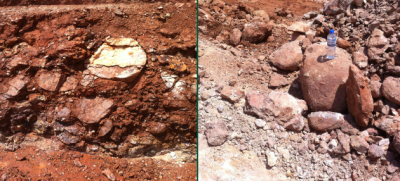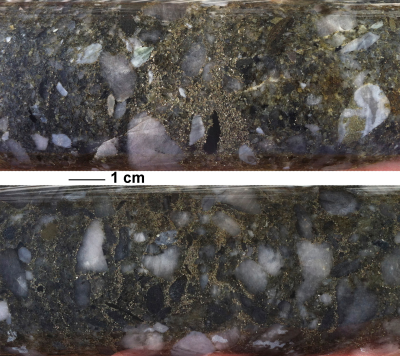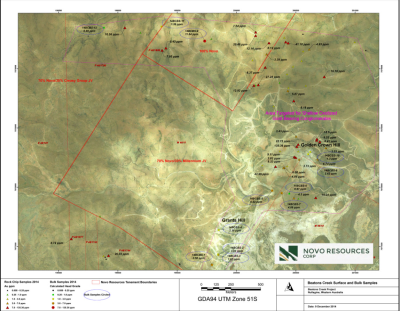VANCOUVER, BC / ACCESSWIRE / December 10, 2014 / Novo Resources Corp. ("Novo" or the "Company")(CSE: NVO; OTCQX: NSRPF) is pleased to announce it has received new positive metallurgical test results from its Beatons Creek gold project, Western Australia (please refer to Novo's new releases dated August 28, 2014 and October 29, 2014 for additional background). In August, 2014, Novo collected twelve bulk samples taken from surface outcrops of oxidized gold-bearing reefs and submitted them to Met-Solve Laboratories of Langley, British Columbia for gravity recoverable gold test work (see nearby sample location map at the back of this news release). Floatation and cyanide leach testing were attempted on one sample, 14-BCBS-1, to determine if additional gold recovery could be attained (refer to table below).
Metallurgical test work results from twelve bulk samples:
|
Bulk Sample |
Gravity recovery after 2 mm (P80) crush (%) |
Gravity recovery (aggregate) after 300 micron (P80) grind (%) |
Gravity recovery (aggregate) after 100 micron (P80) grind (%) |
Mass of concentrate/Mass of sample (%) |
Calculated head grade (gpt) |
Gravity + floatation recovery (%) |
Mass of concentrate/Mass of sample (%) |
Gravity + CN recovery (%) |
Sample description |
|
14-BCBS-1* |
48.6 |
66.6 |
71.4 |
0.80 |
3.58 |
91.7 |
2.40 |
99.3 |
Upper reef - Grants Hill; 1 m thick |
|
14-BCBS-2* |
66.4 |
79.0 |
84.3 |
0.64 |
3.83 |
Tests not performed |
Upper reef - Grants Hill; 1 m thick |
||
|
14-BCBS-3* |
58.7 |
73.3 |
80.9 |
0.59 |
1.67 |
Tests not performed |
Lower reef - Grants Hill; 1 m thick |
||
|
14-BCBS-4* |
61.7 |
75.6 |
81.1 |
0.53 |
2.38 |
Tests not performed |
Upper reef - Grants Hill; 1.8 m thick |
||
|
14-BCBS-5* |
46.6 |
86.8 |
92.7 |
0.61 |
6.22 |
Tests not performed |
Lower reef - Grants Hill; 0.8 m thick |
||
|
14-BCBS-6 |
22.1 |
31.1 |
41.9 |
0.63 |
0.67 |
Tests not performed |
Subordinate channel reef - Golden Crown Hill; 0.5 m thick |
||
|
14-BCBS-7 |
68.4 |
82.8 |
88.5 |
0.62 |
4.09 |
Tests not performed |
Channel reef - Golden Crown Hill; 2 m thick |
||
|
14-BCBS-8 |
49.9 |
74.2 |
87.0 |
0.73 |
2.62 |
Tests not performed |
Channel reef - Golden Crown Hill; 1 m thick |
||
|
14-BCBS-9 |
67.9 |
85.5 |
92.3 |
0.59 |
11.64 |
Tests not performed |
Boulder lag reef - back area; 1.8 m thick |
||
|
14-BCBS-10 |
37.4 |
55.6 |
66.3 |
0.61 |
1.30 |
Tests not performed |
Screened tailings from historic processing - Golden Crown Hill |
||
|
14-BCBS-11 |
37.5 |
50.1 |
58.4 |
0.50 |
1.39 |
Tests not performed |
Subordinate boulder lag reef - back area; 2 m thick |
||
|
14-BCBS-12 |
41.8 |
54.0 |
67.3 |
0.51 |
0.98 |
Tests not performed |
Subordinate boulder lag reef - back area; 0.8 m thick |
||
|
* Results announced in a news release dated October 29, 2014 |
|||||||||
Most samples (14-BCBS-1, 14-BCBS-2, 14-BCBS-3, 14-BCBS-4, 14-BCBS-5, 14-BCBS-7, 14-BCBS-8 and 14-BCBS-9) were collected from primary gold-bearing conglomerates (reefs), the target of the Company's current exploration program. Gravity recoveries (80% passing 100 micron) from these eight samples range from 71.4-92.7% and grades range from 1.67-11.64 gpt Au. Three samples (14-BCBS-6, 14-BCBS-11 and 14-BCBS-12) originate from subordinate reefs that are not the focus of exploration, but were tested to better understand whether low-grade conglomerates are also potentially amenable to gravity recovery. Gravity recoveries (80% passing 100 micron) from these three samples range from 41.9-67.3% and grades range from 0.67-1.39 gpt Au. One sample was collected from a trommel spoils pile from an historic mine on Golden Crown Hill. Gravity recovery (80% passing 100 micron) from this sample is 66.3% and its grade is 1.30 gpt Au indicating a significant loss of gold during processing of reef material by simple trommel screening. The mass pull (mass of concentrate/mass of sample) of all twelve samples is less than 1%, making for a high grade concentrate.
Floatation test results from sample 14-BCBS-1 indicate a substantial amount of gold may be extractable from gravity tailings. Although gravity recovery (80% passing 100 micron) is high, 71.4%, simple floatation scavenged an additional 20.3% of the gold in this sample thus generating an overall recovery of 91.7%. Mass pull of floatation concentrate added to gravity concentrate is low, 2.4%. Based on this very positive result, additional floatation testing has been ordered using gravity tailings from remaining samples. Results from this test work are expected back within a month.
Cyanide (CN) leach testing was also attempted on gravity tailings from sample 14-BCBS-1 with aggregate gravity+CN leaching generating an overall recovery of 99.3%. Although this result is encouraging, recovery benefits utilizing CN are probably not sufficient to justify the added capital and operational costs associated with this type of processing. Therefore, the Company considers gravity+floatation as a cheaper, more beneficial alternative. Also, permitting of the latter scenario is much simpler and shorter.
Recent trench sampling revealed a potentially important behaviour of oxidized reef material. While collecting samples, the matrix of many reefs was seen to break away from cobbles and boulders as rock was moved during sampling (see Figure 1 below). The Company believes that it may be possible to significantly upgrade material for processing by first removing largely barren cobbles and boulders. If so, this could mean the tonnage of material that will require grinding may be reduced, a potential cost saver. To test this possibility, further test work will include a component of "scrubbing" whereby material will be tumbled to cleanse cobbles and boulders of gold-bearing matrix. A new bulk sample (250 kgs) has been collected from representative reef material on Golden Crown Hill and is being submitted for bench scale scrubbing, gravity and floatation testing. Results from this new test work are expected back in the first quarter of 2015.
(Figure 1: Left, 1 m high gold-bearing conglomerate horizon exposed in a trench. Hard siliceous boulders and cobbles occur in a dark brown sandy matrix. Gold occurs in matrix material. Right, loosened conglomerate material collected during trench sampling. Water bottle is approximately 20 cm tall. Note that most of the siliceous boulders are free of matrix material. Screening these out may potentially help upgrade matrix material and help reduce costs of grinding in a mill.)
Initial Surface Samples
Screen metallic fire assay results have returned for a suite of 65 surface samples collected in September, part of an extensive surface sampling program targeting near-surface gold-bearing conglomerates (please refer to Novo's news release dated July 24, 2014 in which Novo announces its strategy to move Beatons Creek to bankable feasibility). These samples are mostly from newly recognized reefs and reef extensions at Golden Crown Hill and areas to the north (see nearby sample location map at the back of this news release). Gold grades range from 0.03-135.36 gpt. All samples are spot rock chips from reefs ranging from 0.5-3 meters thick. These results indicate a robust stacked fan reef system is present in areas around Golden Crown Hill. Stacked fans form in delta environments and are associated with meandering river systems. In contrast, reefs approximately 1 km northwest of Golden Crown Hill are sheet-like boulder lag horizons thought to be formed when sea waves cut across the delta fan described above.
Deep Drill Hole
On November 16, 2014, the Company completed a 963.4 m deep vertical diamond core hole drilled in an area approximately 3 km southwest of Grants Hill (please refer to Novo's news release dated October 29, 2014 for details). Partial funding for this drill hole comes from a $200,000 grant from the Western Australian Mines Department (please refer to Novo's news release dated December 17, 2013 for details). This hole encountered siliciclastic rocks dominated by sandstone and pebble conglomerates with lesser shale and cobble conglomerates belonging to the Hardy Formation, the same rock unit that hosts gold-bearing conglomerates at Beatons Creek. Of particular note, a section from approximately 530-550 meters displayed repetitiously bedded pyritic pebble and conglomerate believed to represent a distal facies of the gold-bearing pyritic conglomerates of Beatons Creek (see Figure 2 below). Detrital "buckshot" pyrite occurs in intervals up to 50 cm thick scattered through these conglomerates. Pyrite contents reach 20% in places. Core from this hole was packed and shipped to a laboratory in Perth where it will be logged in detail, sawn, sampled and submitted for assay. Analytic results are expected back in late January or early February.
(Figure 2: Photographs of two select pieces of pyritic conglomerate from the interval 530-550 m of the deep diamond drill completed in November, 2014. Brassy grains are fine, rounded detrital "buckshot" pyrite. Most of the clasts are quartz. These conglomerates are believed to be a distal facies of the gold-bearing conglomerates at Beatons Creek. Assays are awaited.)
"We are very pleased with our recent progress at Beatons Creek," commented Dr. Quinton Hennigh, President, CEO and a Director of Novo Resources Corp. "Our metallurgical results indicate we have a robust case for simple gravity+floatation recovery of gold. We may also have the ability to upgrade ore by screening out barren cobbles and boulders which could save a lot of cost. Surface samples results indicate we have stacked gold-bearing reefs at Golden Crown Hill, and these should be well-suited for selective mining methods. Lastly, our deep hole appears to have intersected pyritic Beatons Creek conglomerates in a distal environment as was expected. We eagerly await results from this hole as well our RC drill holes and remaining surface samples."
Reverse Circulation Drilling and Surface Sampling
On November 16, 2014, Novo concluded its reverse circulation drill program at Beatons Creek. A total of approximately 9,000 m were drilled in 327 holes. The Company's surface sampling program also concluded at this time with over 700 samples collected. This program was designed to gather necessary data to build a significant oxide resource at Beatons Creek (please refer to Novo's news release dated July 24, 2014). All drill and surface samples (first ones announced above) have now been delivered to Genalysis Laboratory, Perth, WA. Due to excessive preparation time needed for these very large samples, results are expected in a steady stream over the next 4-5 months.
During BLEG follow up exploration in August and September, a new gold-bearing conglomerate was discovered near Virgin Creek in the Marble Bar sub-basin. This conglomerate is part of the Hardy Formation, outcrops for approximately 600 meters on strike, is shallowly dipping, and up to 2 m thick. Screen metallic fire assay results from a suite of 20 spot rock chip samples grade between 0.02-5.44 gpt Au. The Company plans more extensive sampling in 2015.
During BLEG follow up exploration in August and September, a new gold-bearing conglomerate was discovered near Virgin Creek in the Marble Bar sub-basin. This conglomerate is part of the Hardy Formation, outcrops for approximately 600 meters on strike, is shallowly dipping, and up to 2 m thick. Screen metallic fire assay results from a suite of 20 spot rock chip samples grade between 0.02-5.44 gpt Au. The Company plans more extensive sampling in 2015.
A planned diamond drill core hole at Contact Creek in the Marble Bar sub-basin, pursuant to a 2014 Western Australian Mines Department grant, did not proceed due to limited drill water availability. Although the Company had identified a source of water, early hot, dry weather caused this source to rapidly dissipate before drilling could commence. The remote location of this drill site precludes trucking water. The Company plans to re-apply for a drilling grant in 2015.
Quality Control and Quality Assurance
Bulk samples subjected to gravity recoverable, floatation and CN soluble gold test work were collected under direct supervision of Dr. Quinton Hennigh, Novo's Chief Executive Officer, President and Director. Each sample weighs approximately 100 kg and was collected by taking channel cuts across the full width of each conglomerate horizon. Samples were submitted to Met-Solve Laboratories of Langley, British Columbia for testing. Surface samples from Beatons Creek are all spot rock chip samples collected by Novo personnel and submitted to Genalysis Laboratories, Perth, WA for screen metallic fire assaying. One kilogram charges were utilized. Surface samples from Virgin Creek are all spot rock chip samples collected by Newmont Exploration personnel and submitted to ALS Laboratories, Perth, WA for screen metallic fire assaying. One kilogram charges were utilized.
Dr. Quinton Hennigh, the Company's Chief Executive Officer, President and Director and a Qualified Person as defined by National Instrument 43-101, has approved the technical contents of this news release.
About Novo Resources Corp.
Novo's focus is to evaluate, acquire and explore gold properties. The company presently has multiple joint ventures earning a 70% interest in approximately 20,000 square kilometers of the Pilbara region, Western Australia. For more information, please contact Leo Karabelas at (416) 543-3120 or e-mail [email protected].
On Behalf of the Board of Directors,
Novo Resources Corp.
"Quinton Hennigh"
Quinton Hennigh
CEO and President
Forward-looking information
Some statements in this news release contain forward-looking information (within the meaning of Canadian securities legislation) including, without limitation, the statement as to the expected timelines relating to receipt of results from various exploration and testing activities, and planned exploration activities. These statements address future events and conditions and, as such, involve known and unknown risks, uncertainties and other factors which may cause the actual results, performance or achievements to be materially different from any future results, performance or achievements expressed or implied by the statements. Such factors include, without limitation, the ability to undertake and complete the planned exploration activities, the receipt of successful results as exploration proceeds, customary risks of the mineral resource exploration industry, dependency upon third parties, assumptions made by management of Novo, as well as Novo having sufficient cash to fund the planned activities.
The Canadian Securities Exchange has not reviewed and does not accept responsibility for the adequacy or accuracy of the content of this news release.
Nearby Sample Location Map
SOURCE: Novo Resources Corp.






